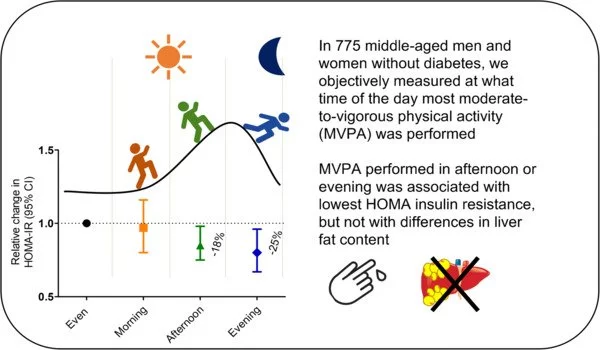Physical activity is essential for diabetes prevention and management. Physical activity on a regular basis can help increase insulin sensitivity, manage blood sugar levels, and lower the risk of developing type 2 diabetes. Physical activity scheduling might also be a component to consider, but it varies from person to person.
Morning and afternoon physical activity are associated with a lower risk of developing type 2 diabetes across all population levels of education and income, according to new research published in Diabetologia (the journal of the European Association for the Study of Diabetes [EASD]), but there is no statistically significant association between evening physical activity and risk of type 2 diabetes. The study is by Dr Caiwei Tian, Harvard University, Cambridge, MA, USA, and Dr Chirag Patel, Harvard Medical School, Boston, MA. and colleagues.
Physical activity is a type 2 diabetes preventative factor, but its timing and consistency (as opposed to the overall sum of physical activity) have received less attention. Accelerometer-based gadgets for measuring physical activity offer a new way to objectively track behavior throughout the day and week. It has been demonstrated that midday-afternoon physical activity, but not evening physical activity, is associated with a lower risk of death when compared to morning physical activity, although the relationship with type 2 diabetes is unknown. The authors of this new study looked at the association between morning, afternoon, and evening physical activity and consistency (routine) with the risk of type 2 diabetes.
Our findings support that total physical activity, but not its consistency over the week, may be an important factor impacting type 2 diabetes risk. The timing of action may play a role in diabetes risk reduction.
Dr. Caiwei Tian
For one week, a cohort of 93,095 UK Biobank participants (mean age 62 years) with no history of type 2 diabetes wore a wrist-worn accelerometer. The scientists used accelerometer data to calculate the metabolic equivalent of task (MET) (a typical measure of physical activity), totaling MET-hours of physical activity.
MET-hour physical activity includes all types of activity performed by an individual during the day and measured using an accelerometer, such as chores, walking, and intense activities. The authors measured completed METs throughout three time periods: 06:00-12:00 hours (morning), 12:00-18:00 hours (afternoon), and 18:00-24:00 hours (evening).
The authors calculated the consistency of physical activity by examining the variance, or difference, between each person’s activity and their own personal average. Those with lower variations were more consistent, and those with larger deviations were less consistent. The authors also looked at the degree of exercise: moderate-to-vigorous physical activity (MVPA) and vigorous physical activity (VPA) in relation to the incidence of type 2 diabetes.
Physical activity was found to have preventive effects, with each 1-unit increase in MET related with a 10% and 9% reduction in risk of type 2 diabetes in the morning and afternoon, respectively. There was, however, no statistically significant link between evening physical activity and the incidence of type 2 diabetes.

The association between morning and afternoon physical activity was mainly linear, indicating that individuals who finished more MET-h had a considerably reduced chance of acquiring type 2 diabetes than those who completed less (10% / 9% per MET-h, for morning and afternoon, respectively).
The authors hypothesized that lifestyle factors such as sleep and dietary consumption would influence the quantity of physical activity done in the morning, afternoon, and evening, and hence the role that activity plays in diabetes risk. The authors addressed these elements in their analytic models to investigate how they influence physical activity. They discovered that when they adjusted for lifestyle characteristics, the connections between MET-hours and different times of day became more exact.
Consistency of MET-measured physical activity was not associated with type 2 diabetes; but intensity was – both MVPA and VPA were associated with decreased risk for type 2 diabetes at all times of the day. The authors say their study is the first report on the effect of consistency of activity, and explain: “The consistency or routine of physical activity was not strongly associated with type 2 diabetes. In other words, individuals who exercise a smaller amount of time more frequently are at no lesser risk for diabetes than individuals who exercise the same total amount, but with less of a routine.”
Unlike previous studies, the authors highlight that one of the strengths of this new research is that they used the MET h as the objective physical activity measurement to take all daily activities into account. Their results were also statistically significant after adjusting for other lifestyle variables including sleep, diet, education and income.
“Our findings support that total physical activity, but not its consistency over the week, may be an important factor impacting type 2 diabetes risk,” the authors write. The timing of action may play a role in diabetes risk reduction.”
“Our study found an association with diabetes risk between morning and afternoon physical activity versus evening physical activity,” they say. The findings also imply that certain higher intensity activity may be beneficial in lowering the chance of acquiring diabetes and other cardiovascular diseases.”





